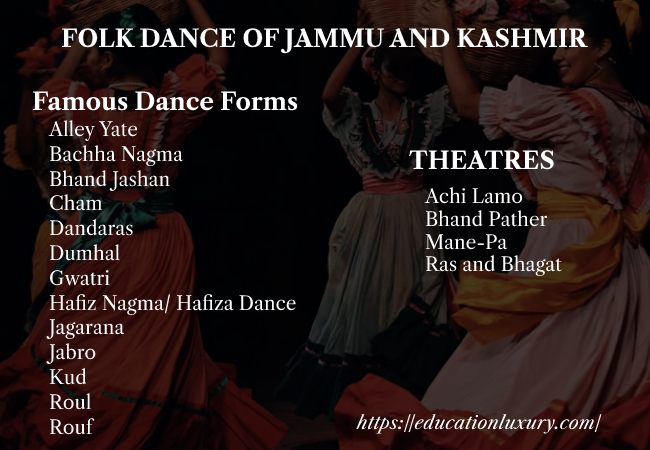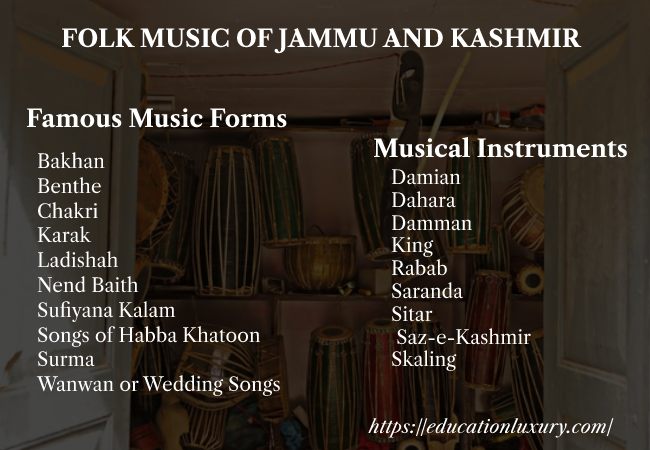The folk dance of Jammu and Kashmir attracts not only Indians but also people from all over the world. These folk dances are performed on different events like at the birth of a child, in crop sowing and harvesting season and on different occasions.
Important folk dance of jammu and kashmir of the state are discussed below:
Alley Yate
This folk dance is very popular in the shepherd community in Zanskar area of Ladakh region. This is a combination of poetry and dance. This dance is performed at the time when people go out of their homes with flocks.
Bachha Nagma
This dance is quite popular in Kashmir valley and performed during harvest season or marriage ceremony by young boys. A light music is used in this dance form. The other name of this dance form is ‘Bachha Gyavaun’ which means ‘adolescent melodious voice’. This folk dance is performed by 6 to 7 boys in a group and among them one boy dresses up as a female dancer who performs Hafiza style of dance. All these dancers are singers, thus, they sing songs while dancing in a melodious voice. The dresses of the dancers look similar that of the Kathak dancers.
Bhand Jashan
The tradition and the history of the Bhand Jashan Dance is performed for many generations. The dance plays an important part of the Kashmir life and culture. The dance conveys the expression through various parodies made out of social situations. This dance is normally performed in the village squares or in a wider arena in front of a huge audience. The dance is performed by the group of fifteen to twenty people, wearing traditional styled attires. In this dance, all the performers put their hands on the waist of their co-dancers and together move backward and forward with the light rhythm of the beating of the musical instruments. The dance is accompanied by the classical musical instrument like Surnai, Shehnai, Peshrao,Dhol and Nagara.
Cham
It is quite popular mask and costume dance of Buddhists of Ladakh monasteries. It is believed that Cham dance was started by Guru Padmasambhava in the late 8th century. This is performed in Buddhist festivals and considered as an act of cleansing of evil forces.
Dandaras
This is one of the popular dance forms in the state which performed during the time of Lohri festival. This is a highly professional dance in which a model of peacock, made of bamboos and coloured paper, is carried by every group of dancers. Every member in the group has a stick in his hand.While dancing, the performers hit the stick in the hand of other person in different postures which makes it difficult. This dance requires high level of skills and practice.
Dumhal
It is the most famous dance of Kashmir which is performed on set locations and set occasions. In this dance, a banner is dig into the ground and a group of men dance around it. They sing in a melodious voice in chorus and perform on drum beats.
Geetru
It is a dance form which is famous in Dogra Pahari area of Jammu. It is performed on the occasion of feasts, festivals and marriages by the rural folks. Both male and female by wearing their traditional costumes participate in this dance-song.
Gwatri
This dance reflects cultural tradition and historical heritage of Jammu and Kashmir. In this form, singers narrate some text and Gwatri dancers enact it simultaneously. This dance represents a harmonious mixture of enchanting melodious with unique dance steps. It refreshes and re-energies the mind and soul of the audience.
Heren
This folk dance is mostly performed in the hilly areas of Jammu region. This traditional theatre style dance form is mainly done during Lohri festival by 10 to 15 members.
Hafiz Nagma/Hafiza Dance
This is a Kashmiri folk dance which is related to Sufiana music. This dance is performed during wedding ceremonies. Santoor, a musical instrument is used in this dance. A female dancer known as Hafiza, dance along with her male counterparts with instruments.
Jagarana
This dance style is performed by the females of the bridegroom’s house when men folk have gone with barat. It is performed by a group of females consisting 15-20 members. It depicts emotions of women folk. It is mainly performed in Jammu region.
Jabro
This dance is mainly performed by nomadic people of Changthang and Rong areas of Ladakh region during Losar festival. While reciting melodious songs, both males and females form two rows or circles and dance leaping hand-in-hand forward and backward movements.
Kud
This ritual dance is performed in the honour of local deity by the farmers of Jammu region during nights. During rainy season, around 20 to 30 people of all ages participate in this folk dance. Narsingha, Chhaina, flute, drums, etc musical instruments are used in this dance form.
Roul
It is a popular and common form of dance among the women of Jammu and Kashmir. It reflects the unique cultural heritage and traditional legacy of the region. It is performed mostly during special festive occasions of marriage or religious festivals. The beautiful Roul dance is a delight for the local inhabitants as well as the tourists, who are enchanted with the beautiful folk music and the unique dance steps.
Rouf
It is a famous customary dance of Kashmir region which is mainly performed on Eid and Ramzan days by a group of girls. In this dance, performer stand face to face, holding hands of the neighbouring partner and together sway their feet forward and backward. It is also done on set of spring season and remained popular since ancient times.
Wuegi-Nachun
It is a ritual dance of Kashmir. It is performed after marriage ceremony when the bride lefts for new home. The dance is performed by the Kashmiri Pandit women who dance around the bridal rangoli.
Folk Theatres of Jammu and Kashmir
The state of Jammu and Kashmir has its own genre of theoretical performance where no clear-cut categories of dance, drama or music are applicable. It is a sort of total theatre i.e. a combination of many media. Achi Lamo and Mane-Pa in Ladakh and the Ras and Bhagat in Jammu region have a fine combination of all these form.
Achi Lamo
This performance usually depicts some Buddhist Jatik Katha, accompanied by dance, music and drama. The performers normally come from Tibet where the performance is called Topa Khamba. Ladakhi people have adopted this form and have been performing it in open.
Bhand Pather
The word ‘Bhand’ means ‘actor or performer’ and the word ‘pather’means ‘Drama’. It is a traditional folk theatre of Kashmir valley in which performers dress up according to their character and entertain the viewers. It is mainly done by men folk who also play the female characters and make this dance more humorous. It depicts short stories based on social and traditional evils of society and performed in various social and cultural functions. This performance is done by a group of 10-15 people with a light music.
Mane-Pa
Mane-Pa has more emphasis on narration and dialogue than in Achi-Lamo and is enacted in Ladakh by the professional Mane-Pa families only.While entertaining and providing humor to the audience, the actor mocks and laughs at the irrationality of the common people.
Ras and Bhagat
Folk theatre in Jammu region has religious ramifications. The popular performances are those showing scenes from Indian epics such as Mahabharata and Ramayana.The Ras or Bhagat mandalis, usually from adjoining states of Punjab and Himachal


